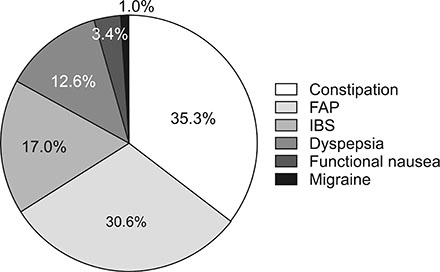Pediatr Gastroenterol Hepatol Nutr.
2018 Oct;21(4):264-270. 10.5223/pghn.2018.21.4.264.
Initial Diagnosis of Functional Gastrointestinal Disorders in Children Increases a Chance for Resolution of Symptoms
- Affiliations
-
- 1Referral Centre for Pediatric Gastroenterology and Nutrition, Children's Hospital Zagreb, Croatia. ivahojsak@gmail.com
- 2School of Medicine, University of Zagreb, Zagreb, Croatia.
- 3School of Medicine, University J.J. Strossmayer of Osijek, Osijek, Croatia.
- KMID: 2421988
- DOI: http://doi.org/10.5223/pghn.2018.21.4.264
Abstract
- PURPOSE
The aim of this study was to describe functional gastrointestinal disorders (FGID) presented in a tertiary medical center, characteristics of patients and results of the diagnostic work-up together with an outcome during the follow up.
METHODS
This was a retrospective, single center, observational study including all patients who were diagnosed with FGID based on Rome III criteria from January to December 2015 in tertiary medical center.
RESULTS
Overall 294 children were included (mean age, 8.9 years [range, 1-18 years]; 165 females). Majority had functional constipation (35.4%), followed by functional abdominal pain (30.6%), irritable bowel syndrome (17.0%), functional dyspepsia (12.6%), functional nausea (3.4%) and abdominal migraine (1.0%). Regression model found that only significant factor associated with improvement of symptoms is the establishment of the functional diagnosis at the first visit (hazard ratio, 2.163; 95% confidence inverval, 1.029-4.544). There was no association between improvement of symptoms and presence of alarm signs/symptoms (weight loss, nocturnal symptoms and severe vomiting) at diagnosis. Furthermore, in pain symptoms (functional abdominal pain, irritable bowel syndrome, dyspepsia) no treatment positively correlated with pain improvement.
CONCLUSION
Regardless of the initial diagnosis of FGID, positive diagnosis at the first visit increases a chance for resolution of symptoms.
Keyword
MeSH Terms
Figure
Cited by 1 articles
-
Nationwide Survey for Application of ROME IV Criteria and Clinical Practice for Functional Constipation in Children
Hyo-Jeong Jang, Ju-Young Chung, Ji-Hyun Seo, Jin Soo Moon, Byung-Ho Choe, Jung Ok Shim
J Korean Med Sci. 2019;34(26):. doi: 10.3346/jkms.2019.34.e183.
Reference
-
1. Drossman DA. Functional gastrointestinal disorders: history, pathophysiology, clinical features and Rome IV. Gastroenterology. 2016; 150:1262–1279.e2.
Article2. Hyams JS, Di Lorenzo C, Saps M, Shulman RJ, Staiano A, van Tilburg M. Functional disorders: children and adolescents. Gastroenterology. 2016; 150:1456–1468.3. Scarpato E, Kolacek S, Jojkic-Pavkov D, Konjik V, Živković N, Roman E, et al. Prevalence of functional gastrointestinal disorders in children and adolescents in the Mediterranean region of Europe. Clin Gastroenterol Hepatol. 2018; 16:870–876.
Article4. Di Lorenzo C, Colletti RB, Lehmann HP, Boyle JT, Gerson WT, Hyams JS, et al. Chronic abdominal pain in children: a technical report of the American Academy of Pediatrics and the North American Society for Pediatric Gastroenterology, Hepatology and Nutrition. J Pediatr Gastroenterol Nutr. 2005; 40:249–261.
Article5. Dhroove G, Chogle A, Saps M. A million-dollar work-up for abdominal pain: is it worth it? J Pediatr Gastroenterol Nutr. 2010; 51:579–583.
Article6. Rasquin A, Di Lorenzo C, Forbes D, Guiraldes E, Hyams JS, Staiano A, et al. Childhood functional gastrointestinal disorders: child/adolescent. Gastroenterology. 2006; 130:1527–1537.
Article7. Schmulson MJ, Ortiz-Garrido OM, Hinojosa C, Arcila D. A single session of reassurance can acutely improve the self-perception of impairment in patients with IBS. J Psychosom Res. 2006; 61:461–467.
Article8. Assa A, Ish-Tov A, Rinawi F, Shamir R. School attendance in children with functional abdominal pain and inflammatory bowel diseases. J Pediatr Gastroenterol Nutr. 2015; 61:553–557.
Article9. Warschburger P, Hänig J, Friedt M, Posovszky C, Schier M, Calvano C. Health-related quality of life in children with abdominal pain due to functional or organic gastrointestinal disorders. J Pediatr Psychol. 2014; 39:45–54.
Article10. Spee LA, Lisman-Van Leeuwen Y, Benninga MA, Bierma-Zeinstra SM, Berger MY. Prevalence, characteristics, and management of childhood functional abdominal pain in general practice. Scand J Prim Health Care. 2013; 31:197–202.
Article11. Helgeland H, Flagstad G, Grøtta J, Vandvik PO, Kristensen H, Markestad T. Diagnosing pediatric functional abdominal pain in children (4-15 years old) according to the Rome III criteria: results from a Norwegian prospective study. J Pediatr Gastroenterol Nutr. 2009; 49:309–315.
Article12. Saps M, Nichols-Vinueza DX, Rosen JM, Velasco-Benítez CA. Prevalence of functional gastrointestinal disorders in Colombian school children. J Pediatr. 2014; 164:542–545.e1.13. Miele E, Simeone D, Marino A, Greco L, Auricchio R, Novek SJ, et al. Functional gastrointestinal disorders in children: an Italian prospective survey. Pediatrics. 2004; 114:73–78.
Article14. Korterink JJ, Diederen K, Benninga MA, Tabbers MM. Epidemiology of pediatric functional abdominal pain disorders: a meta-analysis. PLoS One. 2015; 10:e0126982.
Article15. Gijsbers CF, Benninga MA, Schweizer JJ, Kneepkens CM, Vergouwe Y, Büller HA. Validation of the Rome III criteria and alarm symptoms for recurrent abdominal pain in children. J Pediatr Gastroenterol Nutr. 2014; 58:779–785.
Article16. Lane MM, Weidler EM, Czyzewski DI, Shulman RJ. Pain symptoms and stooling patterns do not drive diagnostic costs for children with functional abdominal pain and irritable bowel syndrome in primary or tertiary care. Pediatrics. 2009; 123:758–764.
Article17. Tabbers MM, DiLorenzo C, Berger MY, Faure C, Langendam MW, Nurko S, et al. Evaluation and treatment of functional constipation in infants and children: evidence-based recommendations from ESPGHAN and NASPGHAN. J Pediatr Gastroenterol Nutr. 2014; 58:258–274.
Article18. Korterink JJ, Rutten JM, Venmans L, Benninga MA, Tabbers MM. Pharmacologic treatment in pediatric functional abdominal pain disorders: a systematic review. J Pediatr. 2015; 166:424–431.
Article
- Full Text Links
- Actions
-
Cited
- CITED
-
- Close
- Share
- Similar articles
-
- Pharmacological Treatment for FunctionalAbdominal Pain in Children
- Natural History and Overlap of Functional Gastrointestinal Disorders
- High-resolution esophageal manometry in children
- The New Rome IV Criteria for Functional Gastrointestinal Disorders in Infants and Toddlers
- Validation of Rome III Criteria in the Diagnosis of Functional Gastrointestinal Disorders in Korean Patients


